Nanotechnology in construction advances with self-healing concrete and nanofilms that boost durability and longevity. Self-healing concrete uses nanomaterials or embedded capsules to automatically repair cracks with healing agents or bacteria, preventing deterioration. Nanofilms create ultra-thin, protective, and self-cleaning coatings that shield surfaces from water, chemicals, and environmental damage. These innovations reduce maintenance costs and extend infrastructure lifespan. To discover how these cutting-edge developments are shaping smarter, more sustainable structures, keep exploring further.
Key Takeaways
- Self-healing concrete incorporates nanomaterials and capsules that release healing agents to automatically seal cracks.
- Bacteria embedded in nanoconcrete produce calcite to fill gaps, enabling autonomous crack repair.
- Nanofilms act as ultra-thin, self-cleaning protective coatings that enhance durability and resistance against water, chemicals, and scratches.
- These nanotechnologies extend infrastructure lifespan, reduce maintenance costs, and improve structural resilience.
- Challenges include large-scale manufacturing, long-term stability, safety concerns, and integration into existing construction practices.
The Science Behind Self-Healing Concrete
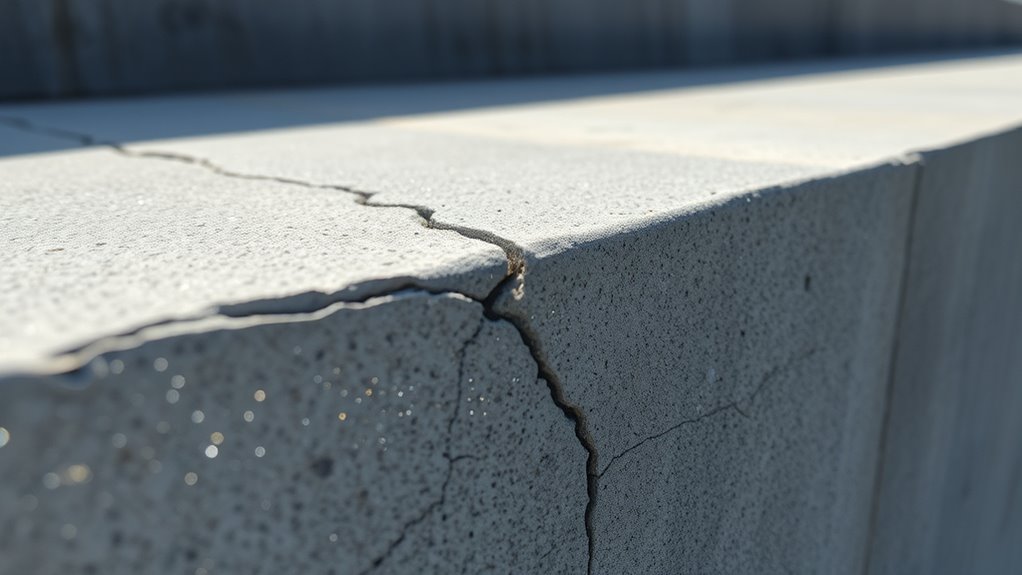
How does self-healing concrete repair itself? When cracks form, tiny capsules embedded within the concrete rupture, releasing healing agents. These agents, often epoxy or other polymers, flow into the cracks and solidify, sealing the damage. Some formulations include bacteria that activate when cracks expose them to moisture, producing calcite that fills gaps. The process is triggered automatically, without human intervention, ensuring durability and longevity. The healing agents are designed to react quickly, restoring structural integrity before further deterioration occurs. This intelligent system reduces maintenance costs and extends the lifespan of concrete structures. By incorporating these smart materials, you get a resilient, self-sustaining building material that actively repairs itself, making construction safer, more sustainable, and cost-effective over time. Protect Your Savings: Avoid Gold IRA Scams
How Nanofilms Enhance Material Performance
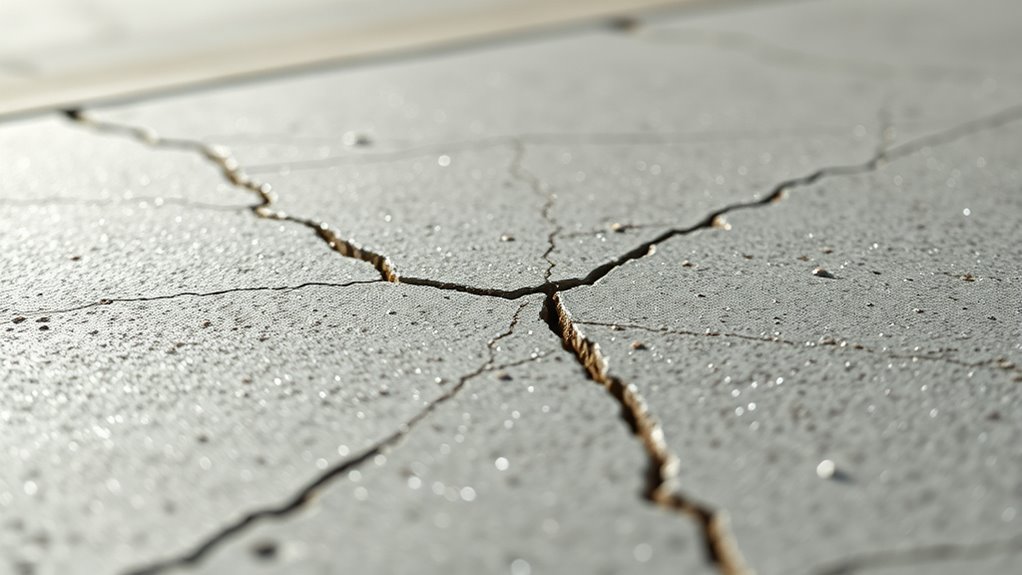
Nanofilms considerably boost material performance by providing a protective, functional layer at the microscopic level. These ultra-thin coatings can prevent corrosion, reduce wear, and shield surfaces from environmental damage. When applied to construction materials like concrete or steel, nanofilms create a barrier that minimizes water, oxygen, and chemical ingress. This protection slows deterioration and extends the lifespan of structures. Additionally, nanofilms can enhance durability by increasing resistance to scratches and impact. They also improve surface properties, such as reducing friction or adding hydrophobicity, which helps keep surfaces cleaner and less prone to mold or algae growth. By fine-tuning surface characteristics at the nanoscale, nanofilms ensure materials perform better over time, making structures more resilient and cost-effective. Incorporating bicycle tire technologies principles, nanofilms can be tailored to improve the wear resistance of surface coatings even further.
Benefits of Nanotechnology in Construction Projects
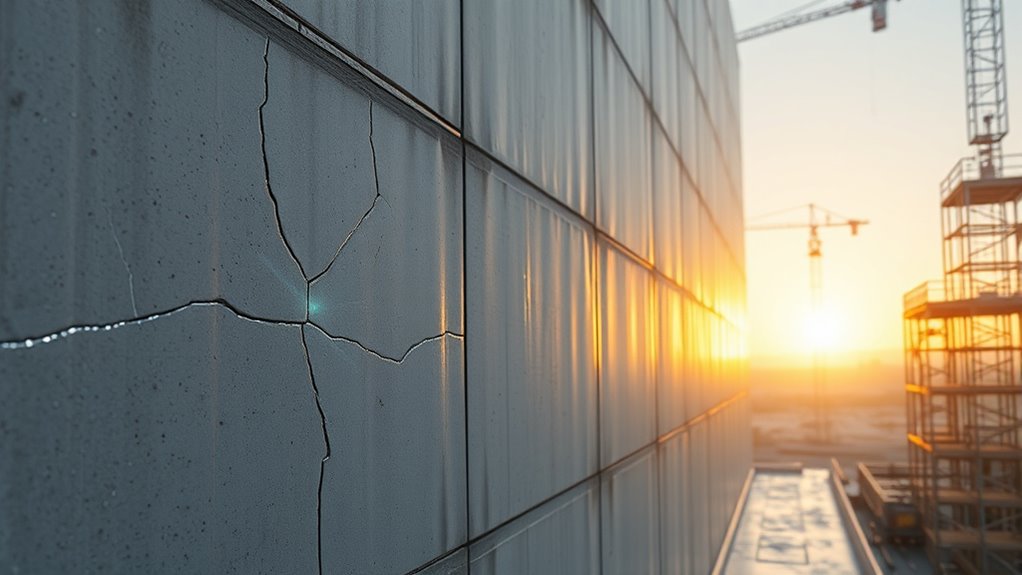
Nanotechnology offers significant benefits for construction projects, making materials more durable and stronger. It can also lead to cost savings and increased efficiency by reducing waste and streamlining processes. As you explore these advantages, you’ll see how nanotech transforms the way we build.
Enhanced Durability and Strength
By integrating nanomaterials into construction materials, engineers can substantially enhance the durability and strength of structures. Nanomaterials improve the bonding properties within concrete and other composites, resulting in increased resistance to cracking and wear. For example, adding carbon nanotubes can reinforce concrete’s microstructure, making it less prone to fractures under stress. Nanoparticles also help in reducing porosity, which prevents water and chemicals from penetrating the material, thereby decreasing corrosion and deterioration over time. These enhancements mean your structures will withstand environmental challenges better and last longer. Additionally, nanotechnology can improve load-bearing capacities without notably increasing weight or material use. Incorporating space and organization strategies in construction projects can further optimize material usage and project efficiency. As a result, your construction projects gain resilience, reducing maintenance needs and extending the lifespan of the infrastructure.
Cost and Efficiency Gains
Integrating nanomaterials into construction not only boosts durability but also offers significant cost and efficiency advantages. By enhancing materials at the microscopic level, you can reduce material waste, speed up construction processes, and lower maintenance costs over time. Nanotech-driven innovations like self-healing concrete and nanofilms streamline project timelines and minimize downtime. You’ll also benefit from improved energy efficiency and longer-lasting structures, reducing long-term expenses. The use of nanoparticle technology in project design further optimizes material properties for specific construction needs.
Current Challenges and Limitations of Nanotech Applications
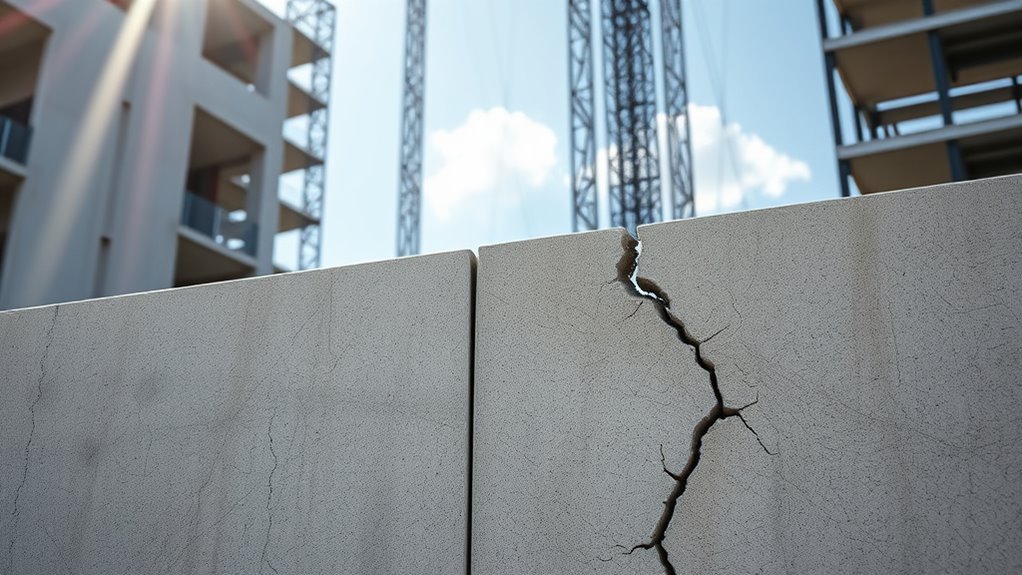
Despite its promising potential, implementing nanotech in construction faces significant hurdles. One major challenge is scalability; producing nanomaterials consistently at large volumes remains complex and costly. You may find that current manufacturing methods are not yet refined enough for widespread use, limiting practical deployment. Additionally, long-term durability and environmental stability of nanomaterials are still uncertain, raising concerns about their performance over time. Safety is another obstacle; the health effects of handling nanomaterials are not fully understood, which could hinder regulatory approval and acceptance. Furthermore, integrating nanotech into existing construction processes requires new techniques and training, slowing adoption. These limitations highlight that, while promising, nanotech’s full potential in construction will need overcoming technical, economic, and safety challenges. Developing self‑healing concrete and other nanomaterial-based solutions will also depend on addressing these issues effectively.
Case Studies Showcasing Innovative Uses of Nanomaterials
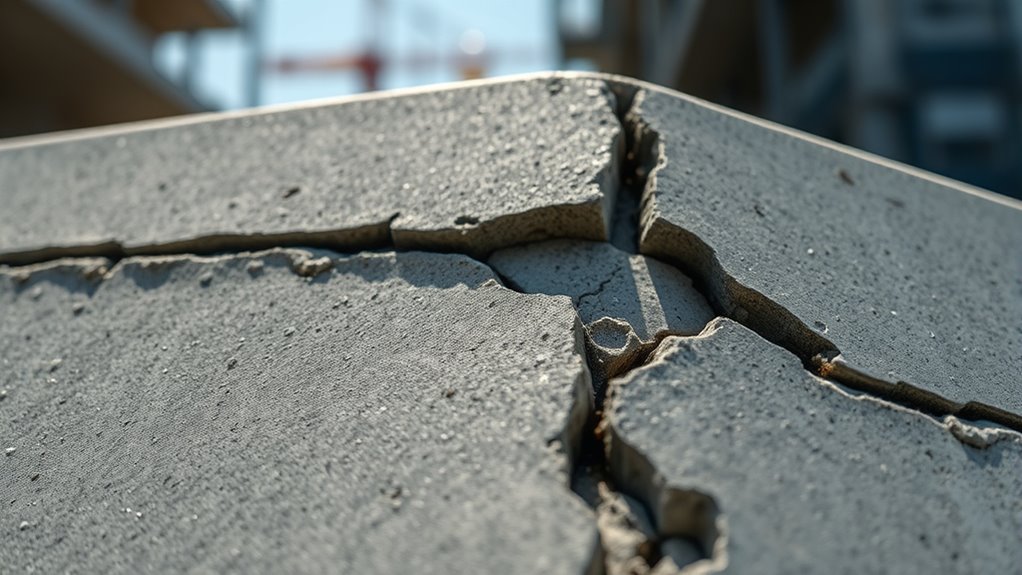
You’ll see how self-healing concrete can automatically repair cracks, extending the lifespan of structures. Nanofilm technologies are enhancing the durability and functionality of building surfaces. These innovative applications demonstrate the real potential of nanomaterials to revolutionize construction practices. Additionally, integrating safe backup systems can further improve resilience and sustainability in modern construction projects.
Self‑Healing Concrete Applications
Self-healing concrete leverages nanomaterials to automatically repair cracks, extending the lifespan of structures. By embedding nanoscale capsules or fibers, this innovative material detects damage and triggers self-repair processes. These nanomaterials can release healing agents like lime or polymer resins when cracks form, sealing gaps before they worsen. This technology has been applied in various projects, reducing maintenance costs and improving durability. For example, bridges and pavements benefit from self-healing properties, ensuring safety and longevity. The integration of nanomaterials enhances crack resistance and minimizes water ingress, preventing corrosion. As a result, structures last longer and require fewer repairs. This breakthrough represents a significant step toward more sustainable, resilient infrastructure. Understanding anime culture and storytelling can further illustrate the importance of innovative materials in modern construction.
Nanofilm Functionalities in Structures
Have you ever wondered how nanomaterials are revolutionizing structural technology? Nanofilms are at the forefront, offering innovative functionalities that enhance building performance. For example, some nanofilms act as ultra-thin, transparent coatings with self-cleaning properties, reducing maintenance needs. Others provide excellent UV protection, preventing material degradation over time. In certain case studies, nanofilms are applied to glass facades to control heat transfer, improving energy efficiency. Additionally, nanofilm coatings can enhance corrosion resistance on metal surfaces, extending lifespan. These applications showcase how nanomaterials enable smarter, more durable structures. As you explore these case studies, you’ll see that nanofilms are transforming traditional construction methods, making buildings not only more resilient but also more sustainable and maintenance-friendly. Furthermore, the development of best hot rollers for long hair demonstrates the ongoing innovation in material applications, paralleling advancements in nanotechnology by providing efficient and versatile solutions.
Future Perspectives and Emerging Trends in Nanotech Construction

As nanotechnology continues to advance, its potential to revolutionize construction practices becomes increasingly evident. Emerging trends point to smarter, more durable, and eco-friendly structures. You can expect increased integration of nanomaterials into everyday construction, leading to self-sensing and adaptive buildings. Innovations such as nano-coatings for enhanced protection, lightweight nanocomposites for easier handling, and energy-efficient nanostructures will reshape industry standards. The development of scalable manufacturing techniques will make these technologies more accessible. Additionally, real-time monitoring through nanosensors will allow you to maintain and optimize structures proactively.
Nanotechnology will revolutionize construction with smart, durable, eco-friendly, and self-sensing buildings through scalable nanomaterials and real-time nanosensor monitoring.
- Integration of nanobots for cleaning and repair
- Development of multifunctional nanomaterials
- Increased focus on nanomanufacturing scalability
- Use of AI-driven nanotech design tools
How Nanotechnology Contributes to Sustainable Infrastructure
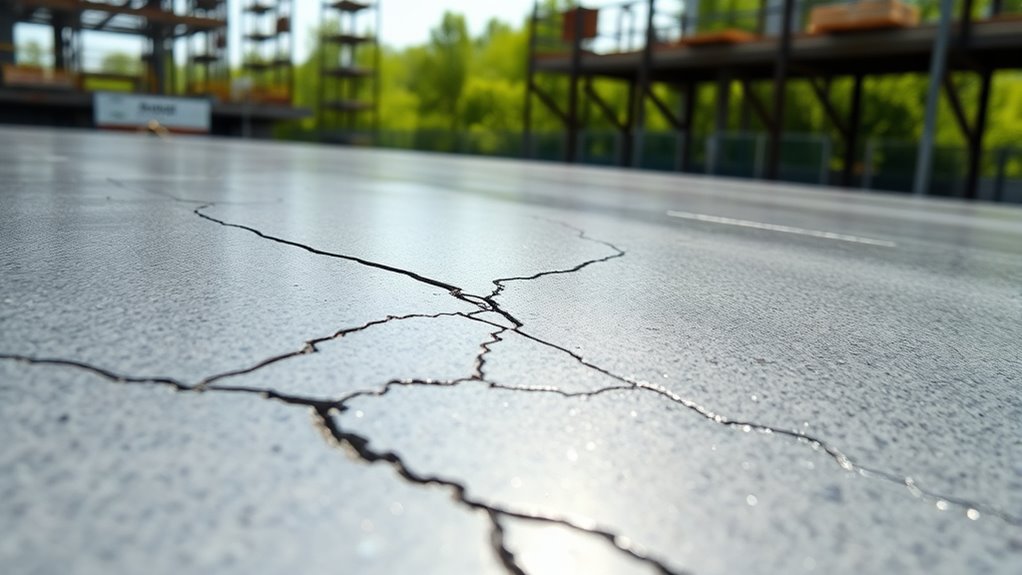
How does nanotechnology enhance the sustainability of modern infrastructure? It improves durability, reducing the need for frequent repairs and replacements. Nanomaterials like self-cleaning nanofilms keep surfaces free of dirt and pollutants, lowering maintenance costs and environmental impact. Incorporating nanotech in concrete creates stronger, longer-lasting structures that require fewer resources over time. These advanced materials also enhance energy efficiency by improving insulation and reducing heating and cooling demands. Additionally, nanotechnology enables the development of eco-friendly, lightweight materials that decrease transportation emissions. For example, the use of vetted Startup Sofa in construction projects exemplifies innovative applications of nanotech. By increasing longevity, reducing resource consumption, and enabling energy savings, nanotech helps you build infrastructure that’s more sustainable, cost-effective, and environmentally responsible. This technology paves the way for smarter, greener cities that meet future needs without overtaxing resources.
Frequently Asked Questions
What Environmental Impacts Do Nanomaterials in Construction Have?
You should be aware that nanomaterials in construction can have mixed environmental impacts. While they improve durability and reduce material use, their production and disposal might release nanoparticles into ecosystems, potentially harming aquatic life and soil health. Additionally, manufacturing processes can consume significant energy, contributing to pollution. It’s essential for you to support responsible nanotech use, ensuring proper regulation and waste management to minimize ecological risks.
How Cost-Effective Is Implementing Nanotech in Large-Scale Projects?
Implementing nanotech in large-scale projects can be like planting a seed with great potential—initial costs are high, but the long-term benefits grow steadily. You might face steep upfront investments, yet the durability and reduced maintenance costs make it cost-effective over time. As the seed matures, your project benefits from fewer repairs and longer lifespan, turning today’s expense into tomorrow’s savings and sustainability.
Are Nanomaterials Safe for Workers During Construction Processes?
You should be aware that nanomaterials can pose health risks if proper safety measures aren’t in place. During construction, you might be exposed to airborne nanoparticles or skin contact, which can cause respiratory or skin issues. To protect yourself, always wear appropriate personal protective equipment, ensure good ventilation, and follow safety protocols. Proper training and handling procedures are essential to minimize potential health hazards associated with nanomaterials.
Can Nanotech Innovations Extend the Lifespan of Existing Infrastructure?
Yes, nanotech innovations can extend the lifespan of existing infrastructure. When you incorporate nanomaterials like self-healing concrete or nanofilms, you’re enhancing durability, reducing maintenance costs, and preventing damage from environmental factors. These advancements work by repairing cracks automatically or creating protective barriers at a microscopic level. So, by adopting nanotech, you’re not only preserving infrastructure but also making it more resilient, saving time and money in the long run.
What Regulatory Frameworks Govern Nanomaterial Use in Construction?
You should be aware that regulations governing nanomaterial use in construction vary by country. In the U.S., agencies like the EPA and OSHA oversee safety and environmental impact, requiring reporting and safety protocols. Europe’s REACH regulation controls chemical substances, including nanomaterials, emphasizing safety assessments. Many regions are developing standards, but you must stay updated on local laws to guarantee compliance, as regulations continue evolving with technological advancements.
Conclusion
By embracing nanotechnology in construction, you can create more durable, self-healing structures that last longer and reduce maintenance costs. Did you know that nanomaterials can improve concrete’s lifespan by up to 50%? This innovation not only boosts sustainability but also transforms how you build resilient infrastructure. As advancements continue, you’ll have the opportunity to shape smarter, greener cities, making a lasting impact on future generations.









